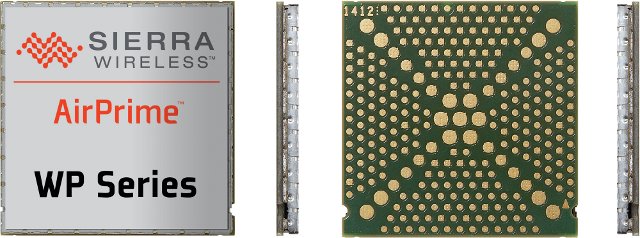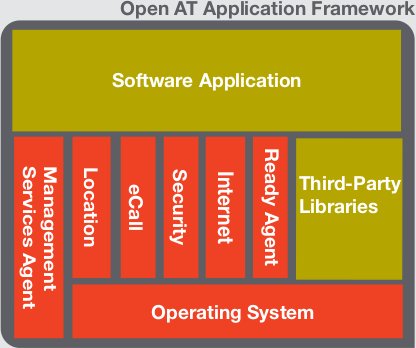Sierra Wireless, a company providing machine-to-machine (M2M) solutions, has recently introduced a new (nameless) architecture for embedded wireless communications comprised of a multicore (again, nameless) “high speed application processor” + Cortex M0 MCU + Radio SoC, secure cloud services (AirVantage) to store the data, and an open application framework with M2M libraries and development tools. This new architecture will be available in the company’s AirPrime WP & AR Series wireless modules to provide 2G to 4G technologies for the Internet of things. WP Series are industrial grade modules to be embedded into applications such as smart metering, remote monitoring, transportation, security systems, networking, and healthcare, whereas AR series will be used for automotive applications.
The 2G versions will feature an M2M system-on-a-chip with a advanced tri-core architecture that includes a 2G EDGE modem, a Cortex A5 ARM application processor, and an ARM Cortex-M0 processor to enable ultra-low power operation. The 3G/4G LTE versions will be based on Qualcomm Gobi 9×15 chipset, a multi-mode modem solution powered by an ARM Cortex A5 processor and running Linux that integrates all the modes of 3G and 4G LTE.
Those wireless modules can then send data securely to AirVantage M2M Cloud which is comprised of 2 components:
- AirVantage Enterprise Platform – Used to collect, transmit, and store machine data, and process and schedule events, from any number of devices, across any network operator around the world.
- AirVantage Management Service – Used to centrally deploy and monitor AirPrime embedded modules, including configuring device settings, delivering firmware and embedded application updates, and administering airtime subscriptions.
Products can be developed with Sierra Wireless’ C/C++ Open AT Application Framework which includes:
- An M2M operating system providing wireless services (voice call, data call, SMS) and TCP/IP connectivity, and gives access to hardware interfaces.
- Libraries called Location (GPS), eCall (Modem), Security, Internet (TCP/IP Stack) and AirVantage agent (M2M Cloud client). There’s also a third party library “WirelessIDEA” that allows you to write your applications in Java.
- Sierra Wireless Developer Studio – Eclipse based integrated development environment
The framework is free to download from Sierra Wireless developer zone and requires a machine running Windows XP/7 with Java 1.6.
Sierra Wireless and ARM are demonstrating the new module architecture both at Mobile World Congress in Barcelona, Spain, and at Embedded World, in Nuremburg, Germany. The demo simulates a wearable healthcare device that could be carried by an elderly person or a patient, and if the person falls, the system detects it thanks to an accelerometer, places a call, and return to low power mode once the call completes. The Cortex M0 takes care of the accelerometer in low power mode (60 uA), an more powerful processor takes care of the call handling (60 to 90 mA). If the system always stay in low power mode, a cell battery should last over 2 years.
Watch the video below for an introduction of Sierra Wireless and their new architecture, and see the demo described above.
You can find more information on http://www.sierrawireless.com/NextGenModules.

Jean-Luc started CNX Software in 2010 as a part-time endeavor, before quitting his job as a software engineering manager, and starting to write daily news, and reviews full time later in 2011.
Support CNX Software! Donate via cryptocurrencies, become a Patron on Patreon, or purchase goods on Amazon or Aliexpress






